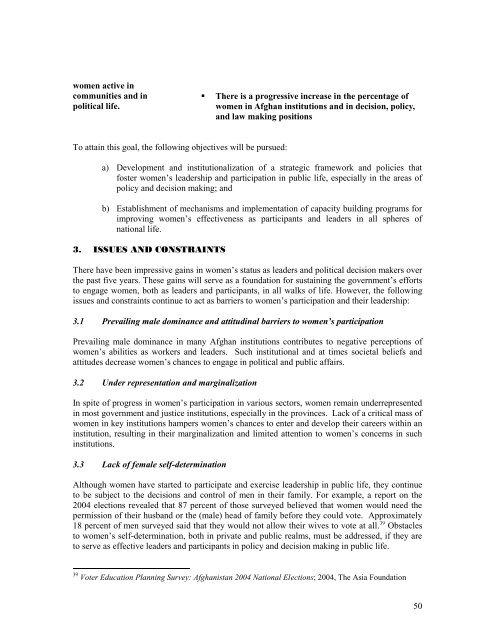National Action Plan for the Women of Afghanistan - The Secretary ...
National Action Plan for the Women of Afghanistan - The Secretary ...
National Action Plan for the Women of Afghanistan - The Secretary ...
- No tags were found...
Create successful ePaper yourself
Turn your PDF publications into a flip-book with our unique Google optimized e-Paper software.
women active in<br />
communities and in<br />
political life.<br />
• <strong>The</strong>re is a progressive increase in <strong>the</strong> percentage <strong>of</strong><br />
women in Afghan institutions and in decision, policy,<br />
and law making positions<br />
To attain this goal, <strong>the</strong> following objectives will be pursued:<br />
a) Development and institutionalization <strong>of</strong> a strategic framework and policies that<br />
foster women‘s leadership and participation in public life, especially in <strong>the</strong> areas <strong>of</strong><br />
policy and decision making; and<br />
b) Establishment <strong>of</strong> mechanisms and implementation <strong>of</strong> capacity building programs <strong>for</strong><br />
improving women‘s effectiveness as participants and leaders in all spheres <strong>of</strong><br />
national life.<br />
3. ISSUES AND CONSTRAINTS<br />
<strong>The</strong>re have been impressive gains in women‘s status as leaders and political decision makers over<br />
<strong>the</strong> past five years. <strong>The</strong>se gains will serve as a foundation <strong>for</strong> sustaining <strong>the</strong> government‘s ef<strong>for</strong>ts<br />
to engage women, both as leaders and participants, in all walks <strong>of</strong> life. However, <strong>the</strong> following<br />
issues and constraints continue to act as barriers to women‘s participation and <strong>the</strong>ir leadership:<br />
3.1 Prevailing male dominance and attitudinal barriers to women’s participation<br />
Prevailing male dominance in many Afghan institutions contributes to negative perceptions <strong>of</strong><br />
women‘s abilities as workers and leaders. Such institutional and at times societal beliefs and<br />
attitudes decrease women‘s chances to engage in political and public affairs.<br />
3.2 Under representation and marginalization<br />
In spite <strong>of</strong> progress in women‘s participation in various sectors, women remain underrepresented<br />
in most government and justice institutions, especially in <strong>the</strong> provinces. Lack <strong>of</strong> a critical mass <strong>of</strong><br />
women in key institutions hampers women‘s chances to enter and develop <strong>the</strong>ir careers within an<br />
institution, resulting in <strong>the</strong>ir marginalization and limited attention to women‘s concerns in such<br />
institutions.<br />
3.3 Lack <strong>of</strong> female self-determination<br />
Although women have started to participate and exercise leadership in public life, <strong>the</strong>y continue<br />
to be subject to <strong>the</strong> decisions and control <strong>of</strong> men in <strong>the</strong>ir family. For example, a report on <strong>the</strong><br />
2004 elections revealed that 87 percent <strong>of</strong> those surveyed believed that women would need <strong>the</strong><br />
permission <strong>of</strong> <strong>the</strong>ir husband or <strong>the</strong> (male) head <strong>of</strong> family be<strong>for</strong>e <strong>the</strong>y could vote. Approximately<br />
18 percent <strong>of</strong> men surveyed said that <strong>the</strong>y would not allow <strong>the</strong>ir wives to vote at all. 39 Obstacles<br />
to women‘s self-determination, both in private and public realms, must be addressed, if <strong>the</strong>y are<br />
to serve as effective leaders and participants in policy and decision making in public life.<br />
39 Voter Education <strong>Plan</strong>ning Survey: <strong>Afghanistan</strong> 2004 <strong>National</strong> Elections; 2004, <strong>The</strong> Asia Foundation<br />
50
















